
Introduction to Vols. 1-2 of Floy Quintos’ Collected Plays
“Memory after almost sixty years is not to be relied on, but there are a few events, faces, meetings, partings that do cling to the brain unaltered,” wrote Arthur Miller in his elegant introduction to a new edition of Tennessee Williams’ “A Streetcar Named Desire” which came out in 2004.
I remember Miller’s words now that I’m thinking of the first time I made the acquaintance of a play by Floy Quintos. While I can only plead eight years to the day of that fateful meeting as against Miller’s 60 vis-à-vis “Streetcar,” the effect he describes is all too familiar.
The play was “Laro,” and it made for an unforgettable introduction. Let me quote the first paragraph of the review I wrote for the Inquirer:
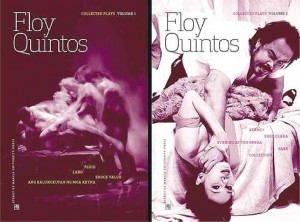
“At the end of ‘Laro [Play],’ Floy Quintos and Miguel Castro’s incendiary new play on twisted love among urban gay men, 10 actors engage in what must be the longest, most unsettling orgy scene in Philippine theater ever… It’s not particularly explicit, if by that is meant the amount of skin bared onstage. Nudity in this case takes a backseat to carefully choreographed blocking and movements, effective lighting and manufactured smoke to suggest the heights (or lows) of homosexual abandon.”
At the time I was still fresh into the business of covering the local theater scene, and “Laro”—an adaptation of Schnitzler’s “La Ronde”—would turn out to be one of the first plays I wrote about. Which is to say that, as far as introductions went, its fairly eye-popping content and staging ensured that the intrepid names behind it would, as Miller put it, “cling to the brain unaltered” for some time.
The play ran for a measly 12 performances—six at Luneta’s open-air theater and six at CCP’s tiny Tanghalang Huseng Batute —in December 2004. It was the peak of the Christmas consumer frenzy, then and now the one season in the year when the only theater the city’s denizens can tolerate is the perky, inoffensive musical kind. “Laro,” being far from such, died a quick death.
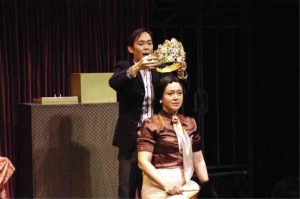
Anyone lucky enough to have seen the play (or unlucky, depending on one’s prudery quotient) could be excused if he or she thought the writers behind it only meant to shock and, along the way, earn a quick buck from the flesh parade.
Observant eye
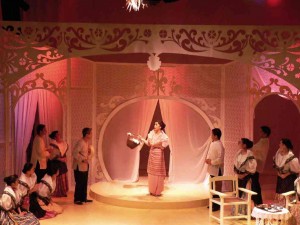
But there was Quintos barely six months later, unveiling a new production of an old play of his at the Wilfrido Ma. Guerrero in UP Diliman. It was “St. Louis Loves Dem Filipinos,” a sweeping historical musical that had all its actors covered in period garb, whose themes and motifs were light years removed from the risqué provocations of “Laro,” and whose impact—no less potent but different—moved me to describe it as “not without shortcomings, but in its present form … already lofty, powerful, consequential—a firm addition to the pool of theatrical musical material exploring the contours of our national soul.”
Clearly, a virtuoso was at work here, a strikingly versatile artist who could straddle wildly differing material with ease, authority and, as I would find out with each new successive enterprise that rolled out from the Floy Quintos playhouse, a singularly observant eye for the defining tropes and mindsets of the zeitgeist.

The nine plays in this collection will, I believe, bear me out. Seven of them (“Fluid,” “Laro,” “Shock Value,” “Ang Kalungkutan ng mga Reyna,” “Atang,” “Evening at the Opera” and “Collection”) represent some of the most cogent, not to mention entertaining, observations into contemporary Filipino life that have been put on stage in recent years.
Two others (“Fake” and “Suor Clara”) revisit Filipino history and literature, riffing on specific period scenarios that, while scrupulously researched, are nevertheless informed by a witty, learned, thoroughly modern sensibility.
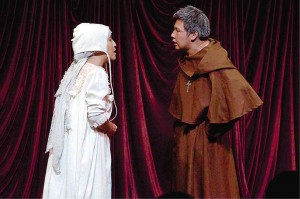
Human scale
As far as I can tell, there are no “universal” characters in the Floy Quintos universe. He seems uninterested in abstraction or allegory, in stories that hoist themselves up on symbolism or metaphor. That peripatetic Everyman will, for once, find no lodging in Quintos’ quarters.
However, recognizable human beings—individuals, in short, fine-grained and vividly rendered—are always welcome.
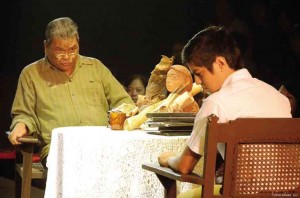
From the austere cloisters of “Suor Clara” to the perfumed art circles of “Fluid,” the claustrophobic boudoir of “Evening at the Opera,” the rancid show-biz haunts of “Shock Value,” the consumerist wasteland in “Collection,” to the corrupt power corridors of “Ang Kalungkutan ng Mga Reyna” (which some have read—wrongly—as a political tract), and even the shimmering byways of memory and tarnished dreams in “Atang,” Quintos’ characters come across as plain, ordinary, one of us, despite—or, come to think of it, because of—their measurable follies and petty idiocies.
It is, however, by their very plainness—by the way they exude solidity, permanence, flesh and blood as well as bile and sinew—that these people cross over imperceptibly, many times movingly, from the mundane to the memorable, from the banal to the universal.
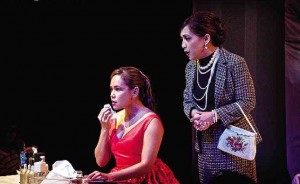
The rigorously human scale of Quintos’ vision translates into smart, chatty snapshots peopled with characters whose veneer of stability often masks certain quirks or perversions that, once poked, provide fodder for good, even explosive, drama.
Such deceptively casual setups earn their topical stripes sans any overt push for a “relevant” thesis or agenda. Instead, their compelling voice comes from the suave, bemused way Quintos chronicles the pleasures and frustrations of living in an age marked by fraying mores, habits and forms of entertainment.
Quick-change artists
Social observation is this playwright’s metier, and human chameleons the object of his affection. In various ways, all of his characters seem, if not on a search for identity, then on their way to discarding the old for a new one.
The denizens of “Laro,” for instance, are nothing if not quick-change artists, starting off as pat stereotypes and then capsizing all our expectations by bolting off with new guises.
The same grand, gut-wrenching act of reinvention animates the titular character of “Suor Clara,” a play that boldly reimagines Rizal’s Maria Clara as revealing herself, on the eve of the 1896 Revolution that sweeps the old order away, to have evolved into a formidable woman of intellect, courage and startling sensuality —all while inside the convent where she had been sent to wither away.
In “Ang Kalungkutan ng Mga Reyna,” meanwhile, the country’s woman president sets wrenching transformation in motion when she declares martial law and prepares to drag an uncomprehending nation into monarchy, believing in her mad heart that the ritual, ceremony and constancy of royalty can finally provide anchor to a tragically rudderless race.
“Ito lang ang natatanging paraan para maligtas ang bayan natin sa walang tigil na pagpalit-palit ng mga pinuno, sa pagtipon ng People Power sa bawat kibot, sa mga pulitikong balimbing, sa masang mapusok ang damdamin, maikli naman ang memorya,” she says.
At one point, the would-be queen—Yolanda La Primera, also known as the “Queen of the Island Kingdom of May-i, Commander of the Legions of Tawalisi, Archduchess of the verdant plains of Moncada and Paniqui in the Dukedom of Tarlac!”—reveals that she’s been stocking up on regal-sounding phrases: “Very well, begin,” or “My lords, how glad I am to receive you.”
“Sa pelikula ko pinagkukuha,” she says.
Unique strength
That throwaway reference to pop culture is not only a comic sleight-of-hand. It also reveals a unique strength of Quintos’ body of work.
No contemporary Filipino playwright anatomizes popular entertainment and celebrity-hood with more caustic, resourceful clout than Quintos. It is the sheer breadth and diversity of his creative pursuits that has given him that perch, allowing him to cover all sides of the aisle when it comes to things high-, low- and middle-brow in this country.
One day he is directing opera or writing a play, the next he is mounting pop concerts and guiding the country’s longest-running show-biz TV talk show beyond its first decade. He also runs an antiques shop, is a recognized maven of Philippine indigenous culture, and has edited lifestyle magazines from fashion and society to food and travel.
Especially in “Atang,” “Shock Value,” “Fluid” and “Collection,” Quintos uses that expert insider knowledge to lay bare the intertextuality of mass entertainment and everyday life. How these two great forces—the gilded menagerie and the legion of voyeurs alternately enthralled and repulsed by it—square off in a kind of strip poker, flinging off old skins and baring new ones in mutual predatory seduction, is a source of obvious fascination for Quintos.
“Narito ang katotohanan tungkol sa negosyong ating pinasukan,” warns a flinty Atang de la Rama in “Atang.” The “sarswela” icon, the country’s first superstar, is advising an ingenue hungry for her own place in the spotlight. “Walang nakakaalala. Maaaring may pakonti-konti, pero ganun lang. Pakonti sila nang pakonti.”
Later on, she underlines the importance of “Misteryo! Kailangan ng artista ng konting misteryo!” before telling the starstruck actress, “Gumawa ka na lang ng sarili mong kuwento. Bilang alagad ng sining, ’yon ang mahalaga… Ang sarili mong kuwento. Ang sarili mong misteryo.”
Truth and identity
The need to create one’s own myth finds a similar vein in “Fluid,” where the central characters of a young gay couple—both struggling artists—end up chipping away at their ideals on their way to easier if less fulfilling lives. One gives in to burnout; the other becomes the latest pop heartthrob, all the while straining to hide his sexuality.
Perhaps Quintos’ most biting, unforgiving entry along this alley is “Shock Value.” In this backstage spoof of the television industry, the illusory nature of truth and identity, rendered even more unrecognizable by fame and stardom, is floodlighted in all its tawdry glory. Celluloid fantasy and blunt reality collide, giving Quintos the excuse to serve up dialogue that bears the mark of overheard conversation.
“Originality ka diyan! This is television!” barks a rattled TV executive. “In this game, there are no loyalties, only ratings and strategies.”
The perks and perils of a life lived for appearances also go on sharp display in “Evening at the Opera,” about a dutiful politician’s wife who, hollowed inside out by her unhappy state, latches on to the idea of bringing opera to the “kapitolyo” in her poor province.
When the play debuted in the 2011 Virgin Labfest, I took note then that “While [it] broke no new ground on the subject of politics and power, as a character study of an otherwise capable woman who has contorted herself into a grotesque life of complicitness and compromise, it was riveting and very nearly devastating.”
Bigger vista
From the personal and intimate, Quintos’ exploration of that pivotal tension between reality and make-believe, between the dour taste of truth and the thrilling power of myth and myth-making, acquires a provocatively bigger vista in “Fake.”
Here, the core moment is a fictional—and entirely plausible—stand-off between two historical figures. In one corner is the fabulist Jose Marco, who passed off as authentic the Code of Kalantiao and other sham documents on the ground that truth is subordinate to a higher calling —the need, in this case, to give a country and its people pride in their native identity after the humiliation of foreign conquest. Facing him, standing for the inviolability of fact, is American historian William Henry Scott, who would expose Marco’s fabrications.
“Quintos’ dramatization of their fictional confrontation,” wrote culture stalwart Jaime Laya in an admiring review, “is the play’s high point, where meet logic and emotion, ends and means, old and new historiography.”
The most recent play in this collection can be seen as an elaboration, a reductio ad absurdum, of “Fake’s” central thought. From Jose Marco’s forgery of historical papers, now it’s the wholesale repackaging of culture and heritage for a country with a largely incurious, utilitarian take on them.
In the blacker-than-black comedy “Collection,” no less than the Banaue Rice Terraces, the Chocolate Hills and much of the rest of the national patrimony is divvied up into charity-auction pieces to be gobbled up by the country’s untiringly adaptive elite (“History is the new handbag!” goes the mantra of an arriviste celebrity spawned by that newfangled animal called social media).
And when the gavel is banged on the final purchase of the jewel of the Cordilleras, out comes a dance troupe in imitation Igorot garb—a parodic punchline on the show-biz gaucherie that more and more seems to define the everyday life and culture of the Filipino.
Thematic preoccupations
If a summation is ever needed of Quintos’ thematic preoccupations, a piece of dialogue near the end of “Fluid” provides something close to it. Here, Renata the skeptic offers sage advice to Mira, an ambitious art patron crushed by her young ward’s ferocious refusal to be pinned down as the Galatea to her Pygmalion:
“You like his art, but you can’t handle the real thing? The raving, ranting, drunken real thing called the artist? You can nurture and develop him all you want, dear. You can polish and sandpaper the rough edges away… But he is a wild animal. He will bite when cornered.”
Like that artist, these plays bite. Yet, surprisingly, despite the fact that a new Quintos drama has graced the local stage almost every year (and, more often than not, won a Palanca; five of the plays in this anthology have won places in the country’s most prestigious literary award), his work is being collected in book form only now.
Short of experiencing them live—always the better option, of course—these first two volumes represent the next best introduction to Quintos’ vital art.
To rattle Arthur Miller’s ghost one last time: May it cling to your brain unaltered as well.
Vols. 1-2 of Floy Quintos’ Collected Plays will be launched on Friday, May 9, 5:30 p.m., at the Ateneo University Press, Ground Floor, Bellarmine Hall, ADMU, with readings of excerpts from the plays by guest artists Shamaine Centenera-Buencamino, Frances Makil-Ignacio, Leo Rialp, Ana Abad Santos, Ron Capinding, JoMari Jose, Jonathan Tadioan and Teetin Villanueva. Inquirer Theater editor Gibbs Cadiz wrote the introduction to both volumes.
The books will retail for P450 each, with 10-percent off for early reservations. Call 4265984, 4266001 local 4613, e-mail [email protected] or visit facebook.com/ateneouniversitypress.









































